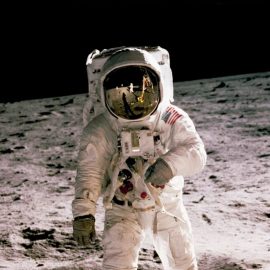

This article is an excerpt from the Shortform book guide to "A Brief History of Time" by Stephen Hawking. Shortform has the world's best summaries and analyses of books you should be reading.
Like this article? Sign up for a free trial here .
Does theoretical physics allow for time travel? And if so, under what conditions could traveling through time be possible?
Believe it or not, there may be some scenarios under which traveling through time is theoretically possible. Specifically, it’d possible if it could be shown that parts of the universe exist where there is negative curvature, which is actually in the realm of possibility as far as theoretical physics is concerned.
Here is why time travel is (theoretically) possible yet extremely unlikely.
The Unlikelihood of Time Travel
To travel back in time, one would need to be able to travel faster than the speed of light. Imagine you were in a rocket traveling from point A to point B. Under the laws of general relativity, all observers would be able to agree that your rocket was at point A before it reached point B—provided that it traveled below the speed of light. But if it were traveling faster than the speed of light, your rocket would outpace its own light being transmitted to observers at point A. Once you arrived at Point B, you would be able to observe your past self leaving Point A. You would be at your destination before you left—in other words, you would have traveled backwards in time.
But physics seems to disallow the possibility of traveling faster than the speed of light—the most advanced particle accelerators very nearly approach it, but never reach it. This is because, according to Einstein’s famous equation, mass increases with speed, and you would need more and more energy to power a rocket past the speed of light, and there will never be enough energy to accelerate beyond this point.
Wormholes
Based on everything we’ve explored, time travel certainly seems like a remote possibility. The no-boundary proposal says that space-time began with a warped curvature that would allow for traveling through time in all directions, including to the past. In the expanding and flattened universe we live in, however, such conditions don’t seem to be possible, at least on a large scale. But might there be local deformities in the universe, conditions where such curvature does still exist?
The best possibility for time travel would be a wormhole that cuts between two regions of space-time. This would be possible if it could be shown that parts of the universe exist where there is negative curvature (like an upside-down U). The positive energy density of matter does not create such conditions. What would be needed is matter with negative energy density. Quantum physics does allow for this, because it says that pockets of negative density can exist as long as they are balanced by positive energy elsewhere in the universe, maintaining the overall positive balance of energy. This would provide conditions for the bending of space-time.
But if time travel is possible, surely we would have seen visitors from the future by now. With a limitless future in front of us, why haven’t they appeared? In looking at the universe, we are already looking at the past, and don’t see the curvature necessary for backward time travel. The future might hold such curvature, so perhaps only forward time travel is possible.Of course, there are the inherent paradoxes baked into the idea of backwards time travel. Perhaps the most famous is the “grandfather paradox,” in which you go back in time and kill your grandfather, which would mean you didn’t exist to travel back in time, which would mean your grandfather is still alive, and so on. The only way around this would be a scenario in which backwards time travel does not allow one to alter the course of events because one enters a zone of alternate history that cannot impact our space-time.

———End of Preview———
Like what you just read? Read the rest of the world's best book summary and analysis of Stephen Hawking's "A Brief History of Time" at Shortform .
Here's what you'll find in our full A Brief History of Time summary :
- The search for a theory that explains the history and evolution of our universe
- Stephen Hawking's discussions about time, space, dimensions, and quantum theory
- How time travel would theoretically work






